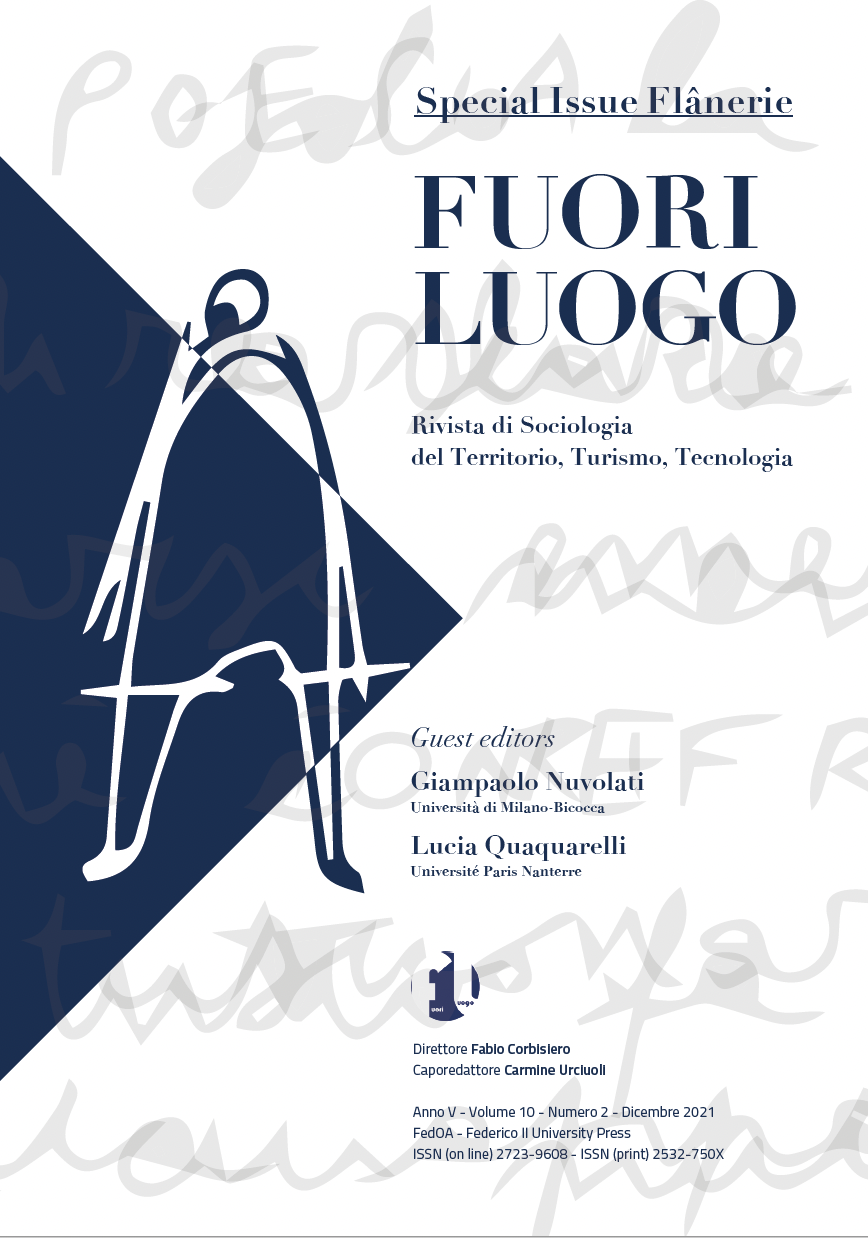Flanerie on the outskirts. A study in the Savena neighborhood of Bologna
Abstract
This proposal is related to two thematic areas of the call: “flânerie in the ancient era and in the contemporary society” and “flânerie and public space: walking and exploring the city as planning practices”. First, it aims to retrace the historical roots of flânerie and the figure of the flâneur between the nineteenth and twentieth centuries: starting from the works of Charles Baudelaire, passing through the contributions of Walter Benjamin and arriving at the recent revival of this technique, both in the Italian and the international debate (Featherstone, 1998; Lentidou, 2006; Nuvolati, 2013; Carrera, 2018). The proposal also intends to highlight the potential role of flânerie at the time of smart city (Nuvolati, 2020), in the belief that this aimless wandering is a tool to imprint new paths to the studies of postmodern city and its outskirts. The exploratory walks of flâneur – witty and open observer, curious researcher endowed with a refined art of gaze, able to pay attention to casual discoveries, anomalies, the marginal of the human being in his daily life – make him able to fix on the details without pre-ordination, to perceive smells, sounds, colors that animate the streets and their users, to rediscover their history and essence and give them new vital lymph to remodel and update their forms where and if this becomes useful or necessary. The use of flânerie is therefore proposed as a technique of cognitive and exploratory research of urban spaces to discover if they are still lived by their inhabitants, how this happens and what are the possible differences in their use compared to a recent past.
The proposed case study concerns a part of Savena, a neighborhood, in the south-eastern outskirts of Bologna. Although it is one of the most prestigious districts of the city, the Via Abba area is characterized by a high presence of public housing with visible signs of decay (empty apartments, missing fixtures, peeling plaster, uneven sidewalks, etc.). At the same time, however, this area is characterized by important services and resources for citizens, such as numerous green areas and places for meeting and socializing: the Edmea Pirami park and the Foscherara Elderly Social Center in via Abba, the Domenico Acerbi garden, the Monte Donato and Paleotto parks, the Casa del Gufo center for the elderly, the School of Peace, the Polisportiva Pontevecchio, just to name a few ones (Municipality of Bologna - Quartiere Savena; Collaborate is Bologna - Via Abba).
The use of flânerie in this case is aimed not only and not so much to bring out the state of degradation of this area, which is already documented and recognizable even to the "naked eye" by the passer-by. The purpose is rather to identify the use and perception of the "latent resources" of these places: their resilience, the "human capital" they have, the hidden aspects of their vitality. To this end, the integration of the flânerie with the production and use of images is also envisaged, both by the researcher and by the residents and users of Via Abba area.
Bibliographical references
Benjamin W. É1927-1940] (1999), The Arcades Project, Harvard University Press, Cambridge MA.
Campa R. (2016), “Flânerie. Perdersi nella metropoli”, Rivista di Scienze Sociali, 14 (testo disponibile online al sito https://www.rivistadiscienzesociali.it/flanerie-perdersi-nella-metropoli/).
Carrera L. (2018), La flânerie. Del camminare come metodo, Progedit, Bari.
Collaborare è Bologna – Via Abba: http://www.comune.bologna.it/collaborarebologna/via-abba/.
Lentiduou L. (2006), “Urban Social movements: from the ‘right to the city’ to transnational spatialities of flâneur activists”, City, 10: 259-268 (testo disponibile online al sito https://www.tandfonline.com/doi/abs/10.1080/13604810600980507).
Featherstone M. (1998), “The Flaneur, the City and Virtual Public Life”, Urban Studies, 35: 909-925 (testo disponibile online al sito https://www-jstor-org.ezproxy.unibo.it/stable/43084038?seq=7#metadata_info_tab_contents).
Nuvolati G. (2013), L’interpretazione dei luoghi. Flânerie come esperienza di vita, Firenze University Press, Firenze.
Nuvolati G. (2020), “Il flaneur perso nella smart city”, Sociologia urbana e rurale, 122: 62-76.
Quartiere Savena – Comune di Bologna: http://www.comune.bologna.it/quartieresavena.
Downloads
Copyright (c) 2022 Gabriele Manella, Barbara Lo Buono

This work is licensed under a Creative Commons Attribution 4.0 International License.




